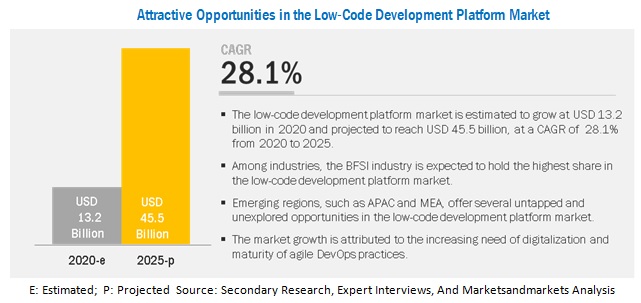Excellent News For Selecting Low-Code Platform Sites
Excellent News For Selecting Low-Code Platform Sites
Blog Article
The Ease Of Use Of Low-Code Apps Is One Of The Main Benefits.
The following factors are key to making low-code development available to non-developers.
Drag-and-Drop Builders: Low-code systems have drag-and-drop interfaces that allow non-developers to design applications without having to write code. This makes the process of developing easier for those with no technical backgrounds.
WYSIWYG editors Editors that use WYSIWYG: These "What You See Is What You get" editors let users design interfaces and workflows that are identical to the final version. This makes it easier to use and understand.
Simple workflow and logic
Visual Workflow modeling: Users design business processes and application logic with visual flowcharts. These models are more intuitive to use than conventional codes.
Low-code platforms typically contain pre-built logic components (e.g., conditional statements loops) that can be easily configured, reducing the need for complex coding.
Reusable Templates and Components
Template libraries that are pre-built: Many low code platforms provide libraries for the most common kinds of software, giving those who are not developers a base to build on and later alter.
Reusable widgets and Modules by using modules or widgets that can be reused users can speed up the creation process by eliminating the need for extensive technical know-how.
Guided Development and Tutorials
Step-by-Step instructions: Platforms usually provide tutorials that are on screen, guided development pathways, as well as other tools to assist developers who are not developers create apps.
Interactive Tutorials - Interactive tutorials that allow you to interact with the platform will help you learn and gain confidence.
Integration with an existing tool:
Seamless Integrate: Low code platforms are designed to seamlessly integrate with the existing systems and tools within business (e.g. the CRM or ERP), which lets non-developers to develop applications to work within current workflows.
APIs, connectors: These tools make integration easier by allowing non-developers (or even end users) to link their applications to external services.
Collaboration Features:
Team Collaboration: Features like real-time collaboration workspaces and shared workspaces make it possible for non-developers to collaborate effectively with business analysts, developers, and other stakeholders.
Access Control Based On Roles: Users who do not develop are able to have access to roles and levels of access that allow them to contribute without compromising security or functionality.
Automated Testing & Debugging
Low-code platforms usually come with testing and debugging software that automatizes these processes. This makes it simpler for non developers to verify their applications work correctly.
Platform highlights errors when they occur and offers fixes. This helps non-developers with solving problems.
Development using low-code is easier for non-developers to access because it allows for democratization of the development process. Low-code applications allow business users to be involved in the creation and maintenance of applications through the use of intuitive visual tools as well as a guiding user experience. This helps bridge the gap between the technical implementation and business needs. View the top get more information on Low-code Platform for application development for more advice including develop web application, rapid action development, build with docker, azure sql, azure sql server, application modernization software, cross platform app development, microsoft azure sql, no code platforms, developing mobile apps and more.
Benefits Of Low-Code Applications In Governance And Safety
Low-code applications provide a number of advantages for governance and cybersecurity, which is crucial to ensure that all apps are managed, well-managed and in compliance throughout their lifespan. Here are some of the key advantages.
Unified Management Console (UMC): Low-code applications typically provide a centralized management console that allows administrators to oversee and manage all the applications and ensure that they have a consistent management system across the company.
Role-Based Access Control RBAC : These platforms typically have robust roles-based access controls, which permit administrators to define and enforce policies. Only authorized users are able to access and modify certain areas of the application.
Compliance and Regulatory Adherence
Many low-code platforms come with integrated compliance features. For instance, they are developed in accordance with the industry standards regulations, laws and standards (e.g. HIPAA, GDPR). These platforms have frameworks and tools to make sure that the applications are compliant to these standards.
Audit Trails and Logging : Comprehensive logging, audit trails and logs are usually integrated into businesses which allows them to monitor changes and monitor access. They also help to make sure that the organization is in compliance with both external and internal regulations.
Increased Security Measures
Data encryption: Low-code platforms commonly offer built-in encryption for data in transit and in transit, ensuring that sensitive information is protected.
Security Certifications - Many lowcode providers have security certifications, such as ISO 27001 (or SOC2), which demonstrate the adherence to high security standards. Customers can rest assured that these providers adhere to these standards.
Automated Security Updates
Regularly scheduled updates and patches Low-code platforms generally manage regular security updates and patches automatically, making sure that applications are secure from latest threats without requiring the intervention of developers.
Security Monitoring: Continuous monitoring of security tools are typically used, which provide immediate alerts and insight into potential security issues.
Data Governance
Data Access Policies These platforms allow organisations to create data access policies and enforce these policies to ensure that the data is only accessible to those who have been granted access. They also ensure the data is utilized in a proper manner.
Data Masking and Anonymization Tools built in to mask data and ensure the security of sensitive information, especially in testing and development environments.
Consistent Application Lifecycle Management
Pipelines for Development and Deployment: Low-code platforms often provide integrated development and deployment pipelines which include security checks to ensure that security remains intact throughout the application lifecycle.
Version Control: An integrated version control system can help manage changes, allowing any changes made to an application to be tracked. If required they can be reversed and the integrity of the application maintained.
User authentication authorization
Single Sign On (SSO): Supporting single sign-on and other advanced authentication techniques simplify management of users while increasing security.
Multi-Factor Authentication Most platforms come with built-in multi-factor support, adding additional security for accessing applications.
Policy Enforcement and Compliance:
Low-code platform often comes with templates for policies that are pre-defined to help organizations implement cybersecurity and governance policies quickly.
Compliance Monitoring Tools - These instruments permit continuous checking of compliance status and provide the ability to report, making it easier to find and correct any issues that might arise.
Integration into Existing Security Infrastructure
seamless intergration: Low code platforms are designed to allow seamless integration with security tools and equipment, like Identity Management Systems SIEM Solutions (Security Information and Event Management), and Firewalls.
API Security API Security Features: Built-in API security functions ensure that integrations with external systems are secure, securing the integrity of data as well as ensuring that applications remain secure.
Training and Best Practices:
Best practices: Many platforms have guidelines for the development of secure applications and provide the best practices. This can help non-developers comply with security standards.
Security Training: A few low-code providers offer security training as well as resources that help users understand how to design and build secure applications.
The security and governance capabilities of low-code applications make sure that they are developed and maintained in a compliant and controlled way. These platforms provide all the tools and frameworks necessary to safeguard sensitive information and enforce policies, while ensuring regulatory compliance. Read the best Enterprise application development with Low-code Platform info for more info including app dev platform, application modernisation, database in azure, rad application development, database in azure, application modernisation, jdbc server, azure sql, app platforms, push alerts and more.
Benefits Of Low-Code Application Development In Terms Of Customization And Limitations
Low-code applications offer an integrated approach that offers substantial advantages when it comes to addressing limitations and allowing for customization. Here are some of the key advantages.
Removing Complexity Barriers
Simple development: Platforms that use low-code reduce complexity by providing templates and components that are pre-built, enabling rapid development and deployment for more complex applications.
A lot of platforms offer automated workflows that help developers to navigate through complex procedures. They minimize the risk of making mistakes and help maintain consistency.
Solutions for scaling:
Scalability Built-In Lowcode platforms usually have features that enable the scalable architecture. They allow applications to handle increasing loads without major changes.
Performance Monitoring Tools: Instruments for monitoring and enhancing performance are built into the application to ensure it's efficient even as it scales.
Security and Compliance
Low-code platforms come with security options, such as role-based security access control encryption, as well as automated checks to ensure compliance. These measures address the common concerns about security.
Regular updates: Platforms regularly change their security protocols and compliance measures. This helps ensure that applications are secure from new threats.
Customization:
Extensibility:
Low-code Platforms Allow Custom Code They allow the integration and usage of customized code.
Developers can add custom modules or plugins to meet the specific requirements of business.
APIs and Integration:
API Support: The extensive support for APIs facilitates seamless integration with other systems and services, which allows for extensive customization and connectivity.
Third-Party Applications Lowcode platforms are usually pre-built with connectors for third-party applications, which makes it easier to integrate them and customize the app.
Flexible UI/UX design:
Customizable user interfaces for developers: Developers can modify and design user interfaces to fulfill specific branding requirements as well as requirements for usability, resulting in an experience that is customized for users.
Responsive Design The built-in capabilities of responsive design guarantee that applications are able to be adapted to different screen sizes and devices.
Business Logic Customization
Visual Workflow Builders: Visual tools used to build and modify workflows. business logic and processes enable developers to design intricate and custom processes with no lengthy programming.
Platforms offer conditional logic to meet certain business rules or situations.
Data Management:
Custom Data Modelling: Developers create custom models that meet specific application needs. They can tailor processing of data according to a company's requirements.
Advanced Data Processing: Integration with advanced tools and capabilities to process data allows flexibility in the way data is analysed, and utilized in your application.
Balanced limitations through customisation
Frameworks and Standards
Best Practices in Compliance Low-code platforms promote adherence to industry best practices and standards. This aids in maintaining high-quality, flexible, and secure apps.
Governance Frameworks Inbuilt governance frameworks will ensure that the customizations don't compromise the integrity, security or security of the application.
Iterative Development:
Rapid prototyping: Through being in a position to quickly prototype and test their modifications developers can improve upon user feedback to improve the functionality of the application.
Low-code platforms are built to support continual enhancement. This permits for modifications and enhancements as business requirements change.
User Empowerment:
Low-code platforms enable citizen developers by allowing non-developers by using intuitive interfaces to modify applications, they increase the pool contributors that can enhance and tailor applications.
Training and Support: Many platforms offer extensive training and support resources to help users make successful modifications that do not compromise the stability of the application, or its performance.
Overall, low code application development provides a robust system to overcome issues and offer a wealth of options for customization. This allows businesses can develop and maintain applications that are both functional and tailored to their specific requirements, while also keeping high standards of quality, security and scaling.